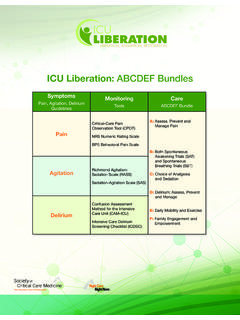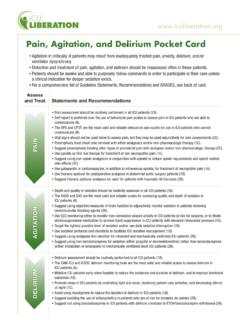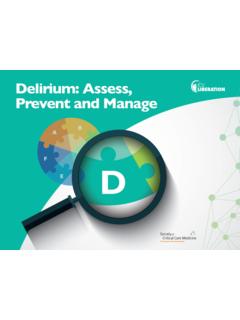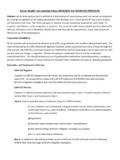Transcription of What About All Those Critical Lines? - ICU Liberation
1 what About All Those Critical Lines? Lines, catheters and drains can be accommodated, securedEVD line stationary bikeWhat About All Those Critical Lines? Patient lines and drains can be accommodatedIncluding Femoral LinesMechanical ventilation and CVVH linesDamluji, A., et al. (2013). "Safety and feasibility of femoral catheters during physical rehabilitation in the intensive care unit." J , C. (2011). "Ambulating with pulmonary artery or femoral catheters in place." CritCare Nurse 31(5): Intensity and DosageIndividualized treatments based on patient prior activity, goalsPT consults for chronic patients, delirious patients, patients unable to lift full leg from mattress Lines, catheters and drains can be accommodated, securedPTs optimize intensity of mobilityGarzon-Serrano, J., C. Ryan, et al. (2011). "Early Mobilization in Critically Ill Patients: Patients' Mobilization Level Depends on Health Care Provider's Profession." PM R 3 (4): 307-313 When Is It Time to Stop and Rest?
2 Patient remains unresponsiveFatigued, pale appearanceRespiratory rate consistently > 10 bpmabove baselineDecreasing muscle recruitmentLoss of balanceDecreasing weight bearing abilityDiaphoresisWhen Quality of Life Is RestoredAvoiding Post Traumatic Stress Disorder in Patients and FamiliesDavydow, D. S., J. M. Gifford, et al. (2008). "Posttraumatic stress disorder in general intensive care unit survivors: a systematic review." Gen HospPsychiatry 30(5): 421-434 ICU DiariesJones, C., C. Backman, et al. (2010). "Intensive care diaries reduce new onset post traumatic stress disorder following Critical illness: a randomised, controlled trial." CritCare MedKEY REFERENCES: Laying the Foundation for E of ABCDEF BundleICU-acquired weakness and cognitive deficits: occur quickly and resolve slowly HerridgeM. N EnglJ Med. 2003;348:683-93. De JongheB. CritCare Clin. 2007;23:55-69. Levine S. N Engl J ;358:1327-35. HerridgeM. N EnglJ Med. 2011;364:1293-304.
3 GrosuH. ;142:1455-60. PuthuchearyZ. ;310:1591-600. Calvo-Ayala E. Chest. 2013;144:1469-80. Kress J. N Engl J ;370:1626-35. Fan E. Am JRespirCritCare Med. 2014;190:1437-46. PandharipandeP. N EnglJ Med. 2013;369 REFERENCES: Laying the Foundation for E of ABCDEF BundleEarly progressive mobility interventions work Thomsen G. CritCare ;36:1119-24. Schweickert W. Lancet. 2009;373:1874-82. PohlmanM. CritCare Med. 2010;38:2089-94. Needham D. Arch PhysMed ;91:536-42. Morris P. Am J Med Sci. 2011;341:373-7. Hopkins R. ;92:1518-23. Lord R. CritCare ;41:717-24. KayambuG. CritCare ;41:1543-54. KayambuG. Intensive Care ;41:865-74. Miller M. Ann Am ThoracSoc. epubMay REFERENCES: Laying the Foundation for E of ABCDEF BundleSafety of early progressive mobility Damluji A. J ;535:e9-15. Winkelman C. Crit Care ;31:70-3. Bailey P. CritCare ;35:139-45. SricharoenchaiT. J ;29:395-400. Perme C. CardiopulmPhysTherJ. 2013;24:12-7. Hopkins R.
4 CritCare ;23:81-96 KEY REFERENCES: Laying the foundation for mobility for femoral catheters PermeC. ;24(2):12-17. Damluji A J. CritCare. 2013 Aug;28(4) PermeC.. J Acute Care ;2(1):32-36. PermeC. Am J RespirCritCare Med. 2009;179 REFERENCES: Laying the foundation for Nursing Progressive Mobility Program in ICU Dang S L CritCare NursQ. 2013;36(2):163-168. ZomorodiM. CritiCare Res Pract. 2012;2012:964547. DammeyerJ. CritCare NursQ. 2013;36(1) is basic nursing care!We Need The Entire Bundle for SuccessKey references: Laying the foundation for implementing the entire bundleImplementing the entire ABCDEF Bundle is crucial! Balas M. CritCare ;42:1024-36. Bassett R. JtCommJ QualPatient Saf. 2015;41:62-74. Klompas M. Am J RespirCritCare ;191:292-301. Miller M. Ann Am ;12 the deficits ICU survivors face and describe the benefits of early mobility in strategies for successful implementation of early mobilization programs in your potential barriers to early mobilization programsQuestion to Ask During Rounds: Did the Patient Achieve his or her Maximal Mobility Activity Today?
5 Did the Patient Achieve his or her Maximal Mobility Activity Today?YES! Mobility is everyone s job! RN, PT, OT, etc. Communicate patient s current mobility status to all ICU team members Encourage patients to perform active movements if possibleDid Our Patient Achieve his or her Maximal Mobility Activity Today?NO! Why not? Was the patient walking before admission? Is the patient hemodynamically stable? Is the patient awake?Why Mobilize Patients in ICU? Side Effects of Bed Rest Muscle strength in a healthy person can decrease to 3% for every day spent on Effects are more profound in older people and in Those with Critical A new study suggests that 3% to 11% strength loss occurs for every day in bed in an ICU Age and days on bedrest are independent predictors of worsening function. ToppR. Am J E. Am JRespirCritCare Med. 2014;190 Benefits of Early Progressive Mobility Decrease ICU and hospital LOS Improve overall physical functioning Decrease duration of mechanical ventilation Decrease incidence of deliriumBailey P.
6 CritCare ;35 P. CritCare Aug;36 Lancet. 2009;373 Activity is Feasible and Safe in Respiratory Failure PatientsResults: 1,449 activity events in 103 patients Sit on bed: 233 ( 16%) Sit in chair: 454 (31%) Ambulate: 762 (53%)Patients with an endotracheal tube in place: 593 activity events 249 were ambulatory (42%)There were < 1% activity-related adverse eventsBailey P. CritCare Med. 2007;35 Activity is Feasible and Safe in Respiratory Failure Patients (cont d.)Conclusion: A majority of survivors (69%) were able to ambulate >100 feet at RICU discharge Patients who went home ambulated farther (mean = 337 feet) than patients who went to a skilled nursing facility (Mean =293 feet)Bailey P. CritCare ;35 ICU Mobility Therapy in the Treatment of Acute Respiratory FailureMorris P. CritCare ;36:2238-43 Early ICU Mobility Therapy in the Treatment of Acute Respiratory Failure (cont d.)Results ICU length of stay: Protocol: days Usual care: days Hospital length of stay: Protocol: days Usual care: daysConclusion Reduced sedation levels in patients Increased activity sessions during ICU stay Net cost savings No adverse events during mobility sessionsMorris P.
7 CritCare ;36:2238-43 Early Physical and Occupational Therapy in Mechanically Ventilated, Critically Ill Patients: A RandomisedControlled TrialResults 104 patients on mechanical ventilation Intervention group: OT/PT median of days after intubation Control group: OT/PT median of days after intubation 1 adverse event with no harm to patient in 498 mobility sessionsSchweickertW. ;373 Intervention group had: Decreased days of delirium (50%) and MV ICU LOS reduced by 2-day median 59% return to independent function at hospital discharge vs. only 35% in control groupEarly Physical and Occupational Therapy in Mechanically Ventilated, Critically Ill Patients: A RandomisedControlled Trial (cont d.)SchweickertW. ;373 AN EARLYPROGRESSIVE MOBILITY ANDEARLY REHABILITATION PROGRAM 0714212802040608050100 ControlInterventionNumber at PHospital Days% Functionally IndependentFunctional Progress Requires an EARLY Investment for the Greatest ReturnSchweickertW.
8 ;373 for ICU Staff Long-term impact for patients and families Benefits of early progressive mobility Role of all team members Specific processesKeys for Successful Early Progressive Mobility and Rehabilitation Program in ICU Program tailored toward specific needs of each ICU Strong nursing mobility program with general nursing guidelines to consistently promote early mobility Strong physical therapy mobility program Specific guidelines for referral to physical and occupational therapy Strong interprofessionalprogram staff commitment Shared vision for early mobility and mutual goals among all members of the team Color signs near the bed to alert staff and families About patient s mobility status Patient and family educational material Appropriate resources Adequate equipmentKeys for Successful Early Progressive Mobility and Rehabilitation Program in ICU (cont d.)Changing Behaviors to Improve Patient Outcomes in ICU Greatly impacts practices at institutions Varies among facilitiesEarly Progressive Mobility in ICUIn-bed mobility Passive range-of-motion exercises Turning side to side Sitting on the side of the bed Active strengthening exercisesOut-of-bed mobility Standing at bedside Sitting on a regular chair Sitting on a cardiac chair WalkingMOBILITY IS EVERYONE S JOB INTHE INTENSIVE CARE UNIT!
9 EquipmentGeneral equipment Chair Portable cardiac monitor Walker Wheelchair IV poles Oxygen tank Transport ventilatorSpecific rehabilitation equipment TheraBand Cuff weights Overhead trapeze and pulleys Standing frame Cycle ergometers Leg press Moveotable Video game systemsConsiderations Before Mobilizing Patients in ICU Neurologic: Level of alertness Cardiac: Hemodynamic stability Vasoactive medications Pulmonary: Ventilation/oxygenation needs Risk vs. benefit Guidelines vs. Protocols Fewerabsolute contraindications Importance of interdisciplinary collaborationHodgson, C. et Care Medicine2014; 18: 658-666 Perceived Barriers to Progressive Early Mobility Severity of disease Severity of weakness Premorbid level of function ICU culture that promotes bed rest Nutritional state Sleep deprivation Level of delirium Pain ObesityAbsolute Contraindications to Progressive Mobility in ICU Patients on neuromuscular blockade Hemodynamic instability requiring escalating dose or multiple vasopressors Significant oxygenation dysfunction requiring high level of oxygen Unstable fractures Cerebral edema with uncontrolled intracranial pressure Active bleeding Intra-aortic balloon pump on femoral artery Pacer dependent with transvenoustemporary pacemaker ECMO with femoral cannulation Femoral arterial sheath Open chest/open abdomenPatient on Mechanical Ventilation AND CVVH with Femoral CatheterPermeC.
10 ;24(2) J. CritCare. 2013 Aug;28(4) PermeC.. J Acute Care ;2(1) Am J RespirCritCare Med. 2009;179 in ICU Patient Physician Nurse Respiratory therapist Physical therapist Occupational therapist Dietitian Pharmacist Nurse assistant Social worker Case manager Chaplain Family Speech therapistDifferent Teams Mobilizing Patientsin ICU Physical therapists and nurses Physical therapists and rehabilitation technicians Physical therapists and occupational therapistsEngel HJ. CritCare ;41(9 Suppl1) J. J Acute Care ;5(1) of Physical Therapy and Occupational TherapyTherapeutic InterventionsPhysical Therapy Education Positioning Exercises Transfers Walking re-education Chest physical therapyOccupational Therapy Education Positioning Exercises Transfers ADLS Splints Cognitive trainingKeys to Optimizing Therapy Interventions Developing individualized plans of care Not protocolizing Stepwise progression Reassessing frequently for changes in statusMobility as a Vital Sign and as an InvestmentConsider the patient activity tolerance on a daily basisGradual progression of activity with adequate rest and recoveryDelirium and altered mental StatusPatient and Family CollaborationPromote: Patient autonomy Communication strategies Use of ICU Diaries Proper sleep/wake cycle Ways to connect to the outside world Family engagement in progressive mobilityEarly Progressive Mobility in ICU:It s Worth the Effort!





